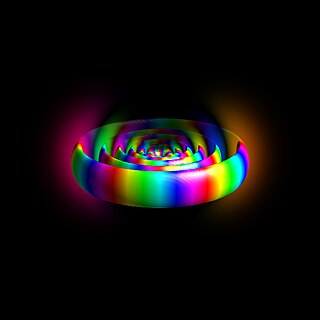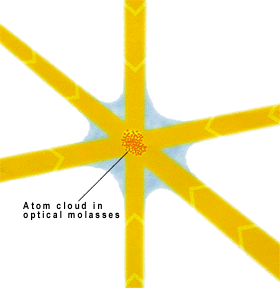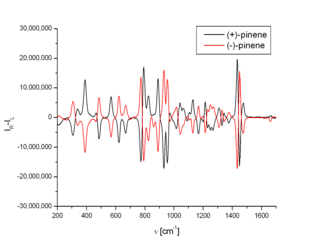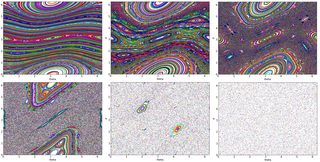Spintronics, also known as spin electronics, is the study of the intrinsic spin of the electron and its associated magnetic moment, in addition to its fundamental electronic charge, in solid-state devices. The field of spintronics concerns spin-charge coupling in metallic systems; the analogous effects in insulators fall into the field of multiferroics.

Samuel Chao Chung Ting is an Chinese-American physicist who, with Burton Richter, received the Nobel Prize in 1976 for discovering the subatomic J/ψ particle. More recently he has been the principal investigator in research conducted with the Alpha Magnetic Spectrometer, a device installed on the International Space Station in 2011.

A magnon is a quasiparticle, a collective excitation of the electrons' spin structure in a crystal lattice. In the equivalent wave picture of quantum mechanics, a magnon can be viewed as a quantized spin wave. Magnons carry a fixed amount of energy and lattice momentum, and are spin-1, indicating they obey boson behavior.

A Rydberg atom is an excited atom with one or more electrons that have a very high principal quantum number, n. The higher the value of n, the farther the electron is from the nucleus, on average. Rydberg atoms have a number of peculiar properties including an exaggerated response to electric and magnetic fields, long decay periods and electron wavefunctions that approximate, under some conditions, classical orbits of electrons about the nuclei. The core electrons shield the outer electron from the electric field of the nucleus such that, from a distance, the electric potential looks identical to that experienced by the electron in a hydrogen atom.
Spin polarization is the degree to which the spin, i.e., the intrinsic angular momentum of elementary particles, is aligned with a given direction. This property may pertain to the spin, hence to the magnetic moment, of conduction electrons in ferromagnetic metals, such as iron, giving rise to spin-polarized currents. It may refer to (static) spin waves, preferential correlation of spin orientation with ordered lattices.

Optical molasses is a laser cooling technique that can cool neutral atoms to temperatures lower than a magneto-optical trap (MOT). An optical molasses consists of 3 pairs of counter-propagating circularly polarized laser beams intersecting in the region where the atoms are present. The main difference between optical molasses and a MOT is the absence of magnetic field in the former. Therefore, unlike a MOT, an optical molasses provides only cooling and no trapping. While a typical Sodium MOT can cool atoms down to 300μK, optical molasses can cool the atoms down to 40μK, an order of magnitude colder.

Raman optical activity (ROA) is a vibrational spectroscopic technique that is reliant on the difference in intensity of Raman scattered right and left circularly polarised light due to molecular chirality.
In optics, the inverse Faraday effect is the effect opposite to the Faraday effect. A static magnetization is induced by an external oscillating electrical field with the frequency , which can be achieved with a high intensity laser pulse for example. The induced magnetization is proportional to the vector product of and :
A NOON state is a quantum-mechanical many-body entangled state:

Photomagnetism is the effect in which a material acquires its ferromagnetic properties in response to light. The current model for this phenomenon is a light induced electron transfer, accompanied by the reversal of the spin direction of an electron. This leads to an increase in spin concentration, causing the magnetic transition. Currently the effect is only observed to persist at very low temperature. But at temperatures such as 5K, the effect may persist for several days.

The kicked rotator, also spelled as kicked rotor, is a prototype model for chaos and quantum chaos studies. It describes a particle that is constrained to move on a ring. The particle is kicked periodically by an homogeneous field. The model is described by the Hamiltonian
The angular momentum of light is a vector quantity that expresses the amount of dynamical rotation present in the electromagnetic field of the light. While traveling approximately in a straight line, a beam of light can also be rotating around its own axis. This rotation, while not visible to the naked eye, can be revealed by the interaction of the light beam with matter.
The orbital angular momentum of light (OAM) is the component of angular momentum of a light beam that is dependent on the field spatial distribution, and not on the polarization. It can be further split into an internal and an external OAM. The internal OAM is an origin-independent angular momentum of a light beam that can be associated with a helical or twisted wavefront. The external OAM is the origin-dependent angular momentum that can be obtained as cross product of the light beam position and its total linear momentum.

Strontium ruthenate (SRO) is an oxide of strontium and ruthenium with the chemical formula Sr2RuO4. It was the first reported perovskite superconductor that did not contain copper. Strontium ruthenate is structurally very similar to the high-temperature cuprate superconductors, and in particular, is almost identical to the lanthanum doped superconductor (La, Sr)2CuO4. However, the transition temperature for the superconducting phase transition is 0.93 K (about 1.5 K for the best sample), which is much lower than the corresponding value for cuprates.
Quantum-optical spectroscopy is a quantum-optical generalization of laser spectroscopy where matter is excited and probed with a sequence of laser pulses.
Spin Hall Magnetoresistance (SMR) is a transport phenomenon that is found in some electrical conductors that have at least one surface in direct contact with another magnetic material due to changes in the spin current that are present in metals and semiconductors with a large spin Hall angle. It is most easily detected when the magnetic material is an insulator which eliminates other magnetically sensitive transport effects arising from conduction in the magnetic material.

Electrons in free space can carry quantized orbital angular momentum (OAM) projected along the direction of propagation. This orbital angular momentum corresponds to helical wavefronts, or, equivalently, a phase proportional to the azimuthal angle. Electron beams with quantized orbital angular momentum are also called electron vortex beams.

Surface differential reflectivity (SDR) or differential reflectance spectroscopy (DRS) is a spectroscopic technique that measures and compares the reflectivity of a sample in two different physical conditions. The result is presented in terms of ΔR/R, which is defined as follow:
Toshiki Tajima is a Japanese theoretical plasma physicist known for pioneering the laser wakefield acceleration technique with John M. Dawson in 1979. The technique is used to accelerate particles in a plasma was experimentally realized in 1994, for which Tajima received several awards such as the Nishina Memorial Prize (2006), the Enrico Fermi Prize (2015), the Robert R. Wilson Prize (2019), the Hannes Alfvén Prize (2019) and the Charles Hard Townes Award (2020).

An electron-on-helium qubit is a quantum bit for which the orthonormal basis states |0⟩ and |1⟩ are defined by quantized motional states or alternatively the spin states of an electron trapped above the surface of liquid helium. The electron-on-helium qubit was proposed as the basic element for building quantum computers with electrons on helium by Platzman and Dykman in 1999.










